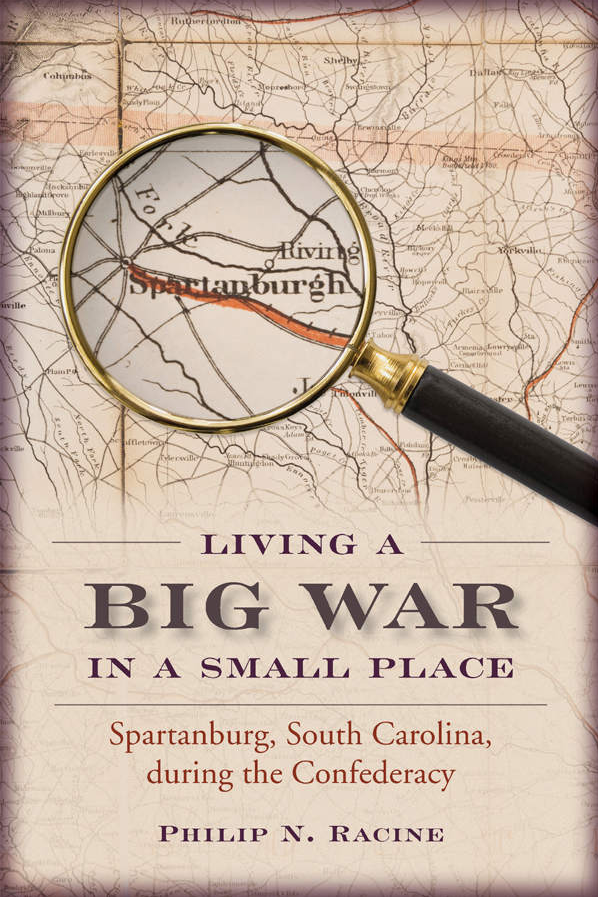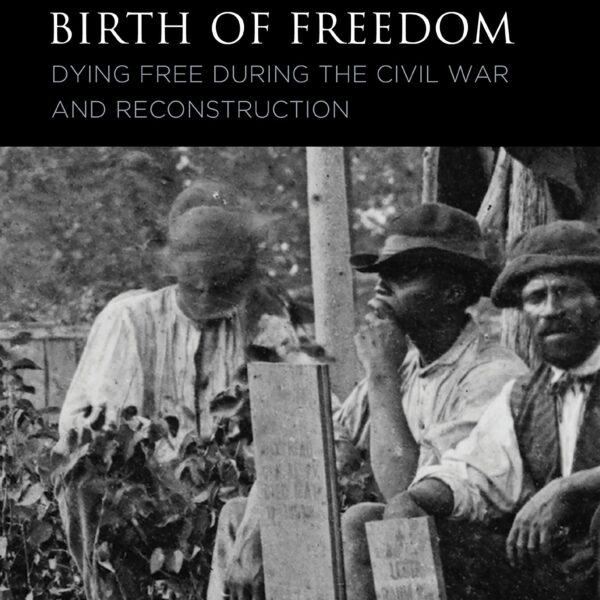Living a Big War in a Small Place: Spartanburg, South Carolina during the Confederacy by Philip N. Racine. University of South Carolina Press, 2013. Paper, ISBN: 1611172977. $21.95.
 As the title suggests, Philip N. Racine’s study of Spartanburg, South Carolina, during the Civil War is a close examination of the way a small town experienced the war’s trials and tribulations. Part One of the book provides the lager backdrop against which to set the individual case studies that comprise Part Two. Racine’s argument is that while Spartanburg may have been distant from the battlefield, it nevertheless reeled from the larger social, cultural, and economic impacts of the conflagration. Spartanburg may have been a small place but, in many ways, its experiences are representative of the larger picture of war.
As the title suggests, Philip N. Racine’s study of Spartanburg, South Carolina, during the Civil War is a close examination of the way a small town experienced the war’s trials and tribulations. Part One of the book provides the lager backdrop against which to set the individual case studies that comprise Part Two. Racine’s argument is that while Spartanburg may have been distant from the battlefield, it nevertheless reeled from the larger social, cultural, and economic impacts of the conflagration. Spartanburg may have been a small place but, in many ways, its experiences are representative of the larger picture of war.
Only a little more than half of the heads of households in Spartanburg District owned land, and thirty percent owned slaves. Located in the northwestern corner of the Palmetto State, Spartanburg itself was little more than a village of 1200 souls — a self-sufficient community largely apathetic to the political tensions of the 1850’s. Although their primary desire was to be left alone, almost everyone in the district supported secession when it came. Still, the firing on Fort Sumter elicited feelings of both euphoria and apprehension. Residents became fearful that spies and traitors would arouse their slaves and destroy the Confederacy from within. There was, however, little foundation for these fears, as Spartanburg was simply too small to attract spies.
Although no battles were fought here, the area became a vicarious witness to the war through the fighting men the district supplied. The community stood firmly behind its soldiers, raising money to support the troops and providing much-needed medical supplies. Women from relief organizations regularly met trains carrying wounded soldiers and hoped eventually to set up a Soldiers’ Wayside House. But most families, having lost their breadwinners, had little to spare. This problem was only exacerbated by rampant inflation, and the Confederate government struggled to assist the destitute. The district had to raise money through taxes, which many resented — illustrating the reluctance of many southerners to think in terms of the greater good.
Added to economic suffering was a breakdown in law and order. Soldiers who came home on legitimate furloughs became angry when they discovered their money was of no value. The hungry took what they needed. The number of deserters coming through the area only increased, and these men stole food and killed livestock. By March of 1865, as William Tecumseh Sherman threatened Columbia, South Carolina, the governor fled to Spartanburg. The sense of panic was infectious. The war finally reached the town in April of 1865, when federal troops in pursuit of Jefferson Davis stopped there. The town may not have suffered any physical destruction, but the emotional strains were severe.
In a chapter that deals with slavery during the war, Racine lays out the demographics and discusses the increasing anxieties amongst whites about how slaves would respond to the war. As a counterpoint to the breakdown of the institution, the author reviews the normal function of the slave system in the pre-war years — although without referencing secondary literature. The growing apprehension over slavery is made most obvious in the harsh sentences handed down by courts for what would have once been considered minor infractions. In 1864, for example, two slaves were executed for petty theft. In the antebellum period, only murder or arson could result in capital punishment.
Part Two of this book deals with four individual case studies, which Racine argues humanize and enhance the larger war narrative. The first case study traces the story of Catherine the slave (inexplicably called Caroline in the reprinted court document), who was accused of arson and sentenced to be hanged, illuminates the extremes of the peculiar institution. Catherine pled guilty rather than be returned to her owner, who apparently beat her cruelly. A petition signed by seventy four locals requested mercy on the grounds that Catherine had been sorely mistreated and that her limbs bore the scars of years of abuse. Ironically, had the petition succeeded, Catherine would have faced her worst nightmare and been returned to her master. Unfortunately, we do not know what the outcome was.
The second case study deals with Emily Harris, who was thirty-three when her husband went off to war and left her at home with six children and ten slaves. Despite her relative success in maintaining the family farm, Emily became increasingly depressed. By the final months of the war, she was actively praying for a speedy Confederate defeat. Emily also became convinced that she was losing control of her slaves, and this only added to her apprehension. When her husband finally returned, he took over the family journal and Emily faded into oblivion.
The final chapters deal with questions of loyalty and the experiences of a wealthy low country planter family that fled to Spartanburg as refugees. These chapters are less comprehensive and their themes are less well drawn out.
This is not a book that will serve to further the academic field, and its lack of engagement with secondary sources makes it unsuitable for the classroom. However, Racine has made excellent use of his knowledge of this locale. He skillfully demonstrates how the experiences of one, small place can reflect the larger themes of a very big war.
Jacqueline Glass Campbell is Associate Professor of History at Francis Marion University and the author of When Sherman Marched North From the Sea: Resistance on the Confederate Home Front (2003).




